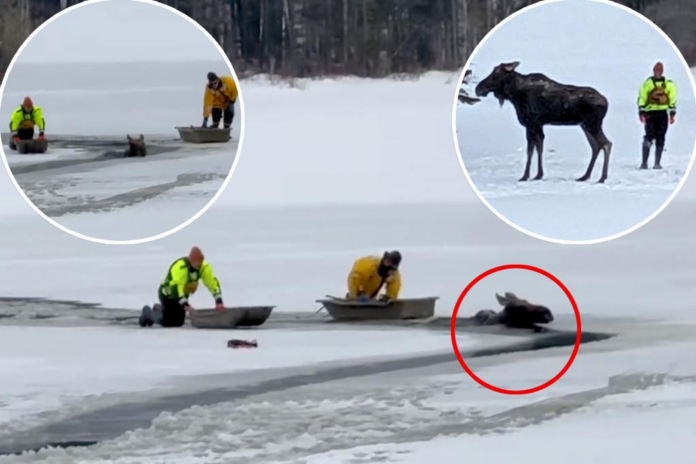NEW YORK (AP) — A bull moose that fell through lake ice in the Adirondack Mountains was saved by New York conservation officials in a laborious cold-water rescue.
The moose fell through the ice around 11 a.m. Thursday, about 200 feet (60 meters) from shore on Lake Abanakee, the New York State Department of Environmental Conservation announced in a statement Friday. That lake is near the town of Indian Lake, about 60 miles (40 kilometers) south of Lake Placid and west of the Vermont border.
“There’s not training manual for getting moose out of the ice,” said Environmental Conservation Police officer, Lt. Robert Higgins, in a video statement recounting the event.
3 Rescued moose emerging from icy waters on Lake Abanakee, aided by forest rangers and police officers in yellow jackets. NYS Department of Environmental Conservation
Higgins was dispatched to the lake thanks to a passerby who saw the moose break through the ice and called it in. Higgins asked for backup, and was quickly joined by a pair of forest rangers.
In New York, moose are sometimes poached by humans, and a handful die every year due to being hit by cars, according to the New York State Department of Environmental Conservation. Across the U.S., these giant deer cousins face challenges from human-caused habitat loss and human-caused climate change that has led to warm summers and oppressive tick infestations, which can cause them to lose their fur.
For this moose, the humans came to help. Moose can die from hypothermia, and they can’t easily climb onto ice once they have fallen through into water. Ice rescues are dangerous because the rescuers can also fall through.
“We were able use our ice rescue training to safely get out there,” said Forest Ranger Evan Nahor, in the video statement.
First they put on dry suits, so they would float and stay warm if they ended up in the water. Then they used a long metal “spud bar” to test the thickness of the ice, which varied from about one to four inches (2.5 to 10 centimeters). They brought safety ropes so that if one fell in, the others could pull them out.
They navigated a path across the lake, following the thickest path to the moose without breaking through, and knelt on sleds to distribute their weight.
3 Forest rangers corralled the moos on their sleds, encouraging the 1,000-pound beast to swim to higher ground. NYS Department of Environmental Conservation
The forest rangers used a chainsaw to cut away sections of ice connecting the area where the moose broke through to a thicker section of ice, while Higgins pushed the ice blocks underneath the channel, to get them out of the way.
The hope was for the moose to swim down the channel and climb out. A bull moose can weigh around 1,000 pounds (455 kilograms), so there wasn’t much chance of them being able to pull it out safely.
The moose didn’t swim toward the thick ice, so they tried to herd it down the channel they had cut. The bull moose wasn’t intimidated by the officials or their big metal sticks.
It was intimidated by their sleds.
“For whatever reason it was scared of those. So once we got behind it, we were able to direct it,” said Matt Savarie, the other forest ranger.
3 The moose appeared tired and shaking after the 2-hour rescue. AP
The giant moose quickly crawled onto the ice, but the cold and constant treading water — the ordeal lasted around 2 hours — had taken its toll.
“It was really tired. I was shivering. It didn’t have much energy left,” Higgins said. “We didn’t know if was going to be able to stand up or not.”
After 15 minutes, it found its footing and got up.
“It was just an amazing sight to see that huge moose stand up right in front of us,” he said.
Then it walked off into the woods.
With Post wires.




